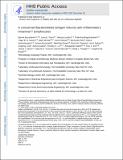A conserved Bacteroidetes antigen induces anti-inflammatory intestinal T lymphocytes
Author(s)
Bousbaine, Djenet; Fisch, Laura I; London, Mariya; Bhagchandani, Preksha; Rezende de Castro, Tiago B; Mimee, Mark; Olesen, Scott; Reis, Bernardo S; VanInsberghe, David; Bortolatto, Juliana; Poyet, Mathilde; Cheloha, Ross W; Sidney, John; Ling, Jingjing; Gupta, Aaron; Lu, Timothy K; Sette, Alessandro; Alm, Eric J; Moon, James J; Victora, Gabriel D; Mucida, Daniel; Ploegh, Hidde L; Bilate, Angelina M; ... Show more Show less
DownloadAccepted version (2.247Mb)
Open Access Policy
Open Access Policy
Creative Commons Attribution-Noncommercial-Share Alike
Terms of use
Metadata
Show full item recordAbstract
<jats:p>
The microbiome contributes to the development and maturation of the immune system. In response to commensal bacteria, intestinal CD4
<jats:sup>+</jats:sup>
T lymphocytes differentiate into functional subtypes with regulatory or effector functions. The development of small intestine intraepithelial lymphocytes that coexpress CD4 and CD8αα homodimers (CD4IELs) depends on the microbiota. However, the identity of the microbial antigens recognized by CD4
<jats:sup>+</jats:sup>
T cells that can differentiate into CD4IELs remains unknown. We identified β-hexosaminidase, a conserved enzyme across commensals of the Bacteroidetes phylum, as a driver of CD4IEL differentiation. In a mouse model of colitis, β-hexosaminidase–specific lymphocytes protected against intestinal inflammation. Thus, T cells of a single specificity can recognize a variety of abundant commensals and elicit a regulatory immune response at the intestinal mucosa.
</jats:p>
Date issued
2022-08-05Department
Massachusetts Institute of Technology. Department of Biological EngineeringJournal
Science
Publisher
American Association for the Advancement of Science (AAAS)
Citation
Bousbaine, Djenet, Fisch, Laura I, London, Mariya, Bhagchandani, Preksha, Rezende de Castro, Tiago B et al. 2022. "A conserved Bacteroidetes antigen induces anti-inflammatory intestinal T lymphocytes." Science, 377 (6606).
Version: Author's final manuscript